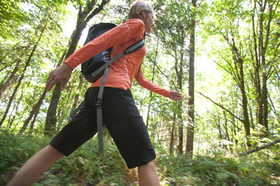MAY 2014
Having trouble viewing this email? View it as a Web page.
Physical Activity

In Alaska, the annual transition from winter to
spring brings an awakening of many types. Bears wake from their deep slumber,
squirrels and birds return life to the forest, and people begin to emerge from
their physical and mental “dens” eager to feel the sun on their faces and
breathe the fresh air that can only be found in the Last Frontier.
In recognition of the spring awakening, May has been
named National Physical
Fitness and Sports Month. The President’s
Council on Fitness, Sports, and Nutrition uses this month
to promote physical activity across the lifespan — among children, adolescents,
and adults. The Council website features a variety of resources and information about why physical
activity is important, physical activity guidelines, and practical tips on how
to get moving. In addition, there are resources for public health practitioners
looking to increase physical activity in their area, including press releases, tweets, e-cards, and website
badges.
Alaskans need more physical activity — 26% of adults
and 79% of high school students don’t get the recommended amount.1
There are several different types of physical
activity: moderate or vigorous, structured or unstructured. Moderate activities
are those that elevate your heart rate but don’t usually work up a sweat.
Vigorous physical activity refers to movements that have you working pretty
hard – usually breaking a sweat and making it hard to carry on a conversation.
Activity does not need to be in the form of a 10-mile
run or 45 minutes on a treadmill. To meet the physical activity
recommendations, people should move in ways they enjoy. Walking, gardening,
dancing, and even household chores all count as physical activity.
The national guidelines call for the following
amounts of physical activity:
-
Early Childhood – 60 minutes each of structured and unstructured
activity.
-
Children and Adolescents – 60 minutes or more each
day, including aerobic, muscle-strengthening, and bone-strengthening
activities.
-
Adults – 150 minutes each week, plus muscle
strengthening twice a week.
-
Older Adults – 150 minutes each week, strength
building twice a week, balance exercises as needed.
Southcentral Foundation has made physical activity an integral part of its services to customer-owners and employees. Their health education and wellness programs provide
exercise education and individual counseling services along with chronic
disease education and self-management, tobacco cessation, and injury
prevention. In addition, a full schedule of group
exercise classes like Zumba®, Pilates, yoga, functional balance, and
strength training are taught both in Anchorage and Wasilla.
Alaska
Success Story – Healthy Futures
Healthy Futures is an
Alaska-grown program started by two parents in 2003 to motivate children to
build the daily habit of physical activity. Healthy Futures supports low- and
no-cost community events that get Alaska families active, such as Ski 4 Kids,
Tuesday Night Races, and school running jamborees. Healthy Futures runs two
free physical activity challenges each year in elementary schools across the
state. Students who complete the challenge get prizes and schools with high
student participation win grants that support their physical and health
education programs.
About three years ago, Healthy Futures became a partner of
the State of Alaska’s Play Every
Day campaign. Play Every Day raises awareness about the health concerns
linked to childhood obesity and inspires Alaska families to be physically
active for the best health.
The Healthy Futures program and Play Every Day campaign have
reached more Alaska families and grown significantly during the past few years.
The number of elementary schools participating in the Healthy
Futures Physical Activity Challenge has jumped from 36 in 2011 to a record 164
schools this spring. In fall 2013, almost 16,000 Alaska children were
physically active during the Healthy Futures Challenge. That is about 1 in 5
elementary-age children in the state of Alaska participating in the Challenge
and logging their physical activity during the month.
- Alaska Department of
Health and Social Services. Alaska Obesity Facts Report – 2012. Anchorage,
Alaska: Section of Chronic Disease Prevention and Health Promotion, Division of
Public Health, Alaska Department of Health and Social Services; August 2012.
|